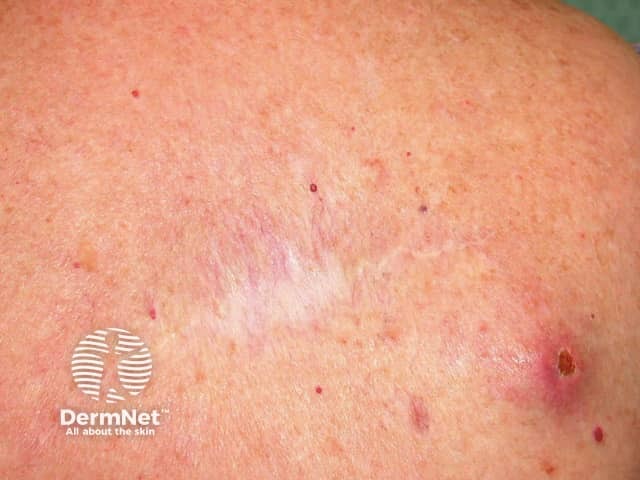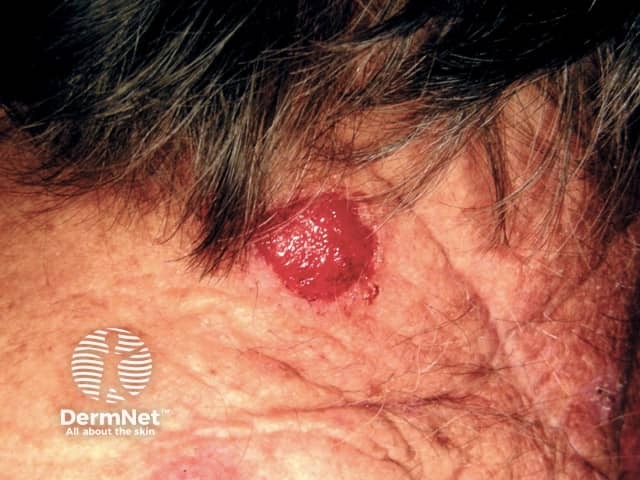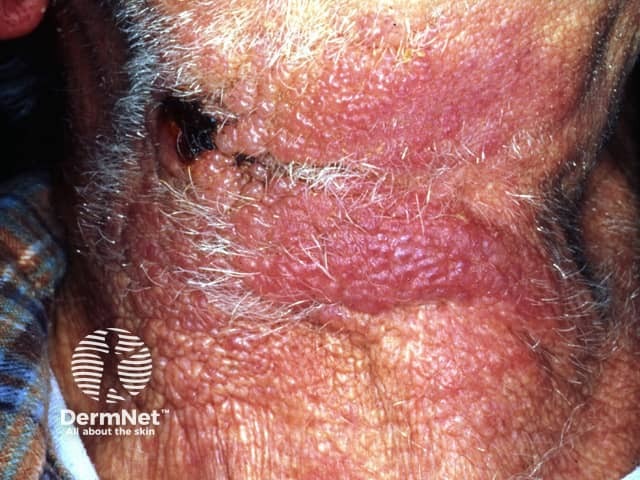Main menu
Common skin conditions

NEWS
Join DermNet PRO
Read more
Quick links
Cutaneous metastasis — extra information
What is cutaneous metastasis?
Cutaneous metastasis (plural ‘metastases’) refers to the growth of cancer cells in the skin originating from internal cancer. In most cases, cutaneous metastasis develops after the initial diagnosis of the primary internal malignancy (such as breast cancer and lung cancer) and late in the course of the disease. In very rare cases, skin metastasis may occur at the same time or before the primary cancer has been discovered and may be the prompt for the further thorough investigation.
Cutaneous metastasis may also occur from skin cancer, usually melanoma. The original or ‘primary’ melanoma produces metastases or ‘secondary’ growths in surrounding or distant skin sites and other tissues such as the lungs or brain.

Metastatic melanoma near excision site

Distant metastatic melanoma

Metastatic melanoma

Metastatic breast cancer

Metastatic breast cancer

Metastatic adenocarcinoma of unknown origin (carcinoma erysipeloides)
What causes cutaneous metastasis?
Cutaneous metastasis occurs when cancerous cells break away from a primary tumour and make their way to the skin through the blood circulation or lymphatic system. Most malignant tumours can produce skin metastasis, but some are more likely to do so than others. When the following cancers have metastasised, they have quite a high chance of affecting the skin.
- Melanoma — 45% chance of developing cutaneous metastasis (but only 15–20% of melanomas metastasise, so the overall chance of a skin metastasis is about 7–10%)
- Breast cancer — 30%
- Nasal sinus cancers — 20% (12%) - Cancer of the larynx — 16%
- Cancer of the oral cavity — 12%
The incidence of skin metastasis varies but is somewhere between 3—10% in patients with a primary malignant tumour.
The sex and age of an individual also appear to determine the frequency of skin metastasis in certain primary cancers. The reason for this is unknown. In women, about 70% of cutaneous metastases originate from the breast. In men, cutaneous metastases are most often from the lung (24%), colon (19%), skin (melanoma, 13%) or oral cavity (12%).
Below lists the common internal cancers that cause skin metastasis in decreasing order of frequency according to sex and age group.
Men |
Women |
||
|---|---|---|---|
40 yr |
> 40 yr |
40 yr |
> 40 yr |
Melanoma Colon cancer Lung cancer |
Lung cancer Colon cancer SCC in the oral cavity Melanoma |
Breast cancer Colon cancer Ovarian cancer |
Breast cancer Colon cancer Lung cancer Ovarian cancer Melanoma |
What are the signs and symptoms of cutaneous metastasis?
Most cutaneous metastasis occurs in a body region near a primary tumour. The first sign of the metastasis is often the development of a firm, round or oval, mobile, non-painful nodule. The nodules are rubbery, firm or hard in texture and vary in size from barely noticeable lesions to large tumours. These may be skin coloured, red, or in the case of melanoma, blue or black. Sometimes multiple nodules appear rapidly. The skin metastases may break down and ulcerate through the skin. Specific patterns include:
- Carcinoma erysipeloides: sharply demarcated red patch due to local spread of primary cancer blocking lymphatic blood vessels in adjacent skin
- En cuirasse or sclerodermoid carcinoma: indurated fibrous scar-like plaques due to cancer cells infiltrating collagen in the skin
- Carcinoma telangiectoides: red patches with numerous blood vessels (telangiectases) or lymphatic vessels (lymphangioma-like).
Depending on the location of the primary tumour, cutaneous metastasis display certain characteristic features.
Organ of cancer origin |
Features of cutaneous metastasis |
|
|---|---|---|
Breast |
|
|
Lung |
|
|
Melanoma |
|
|
Colon and stomach |
|
|
What is the treatment for cutaneous metastasis?
The underlying primary tumour needs to be treated. However, in most cases where skin metastasis has occurred, the primary cancer is widespread and may be untreatable. In this case, palliative care is given and includes keeping lesions clean and dry. Debridement can be done if lesions bleed or crust. Other therapies that may be helpful include:
- Imiquimod cream – may lead to regression of metastasis in some cases of melanoma
- Liquid nitrogen cryotherapy
- Photodynamic therapy
- Excision
- Carbon dioxide laser therapy
- Pulsed dye laser therapy
- Topical and intralesional chemotherapy and cytokines
- Electrochemotherapy, a treatment that uses electrical impulses to enhance effectiveness bleomycin or cisplatin injected into tumours.
In many cases, cutaneous metastasis causes disfigurement and discomfort. Removal of skin lesions by simple excision may enhance the patient’s quality of life but has little effect on the final outcome that is dictated by the primary cancer.
References
- Book: Textbook of Dermatology. Ed Rook A, Wilkinson DS, Ebling FJB, Champion RH, Burton JL. Fourth edition. Blackwell Scientific Publications.
- Dermatologic Manifestations of Metastatic Carcinoma of the Skin — Medscape Reference
On DermNet
- Skin lesions, tumours and cancers
- Skin cancer
- Melanoma
- Metastatic melanoma
- Metastatic melanoma with unknown primary
- Radiographic investigations in melanoma
- Diffuse melanosis cutis
- Metastatic adenocarcinoma pathology
- Vulval cancer
